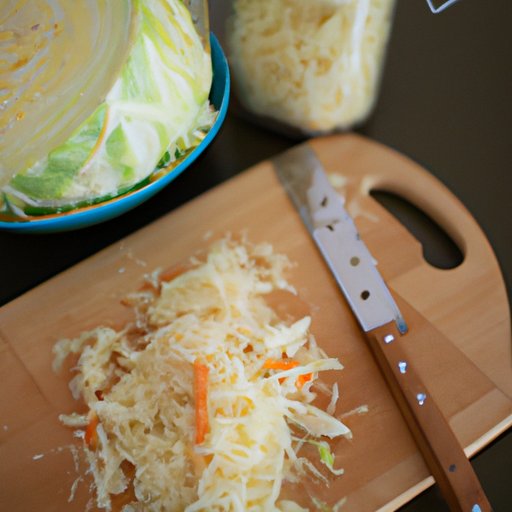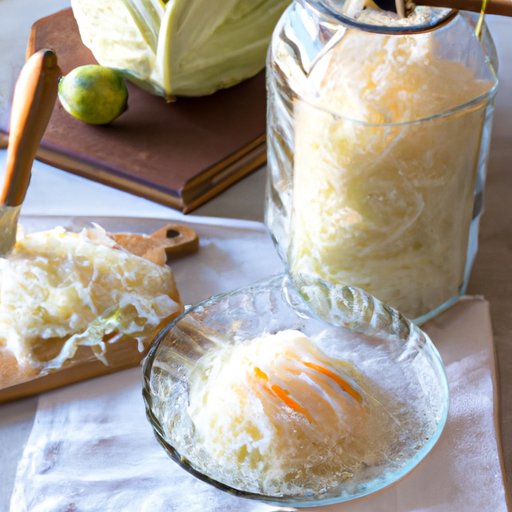Introduction
Sauerkraut is a beloved and classic German dish that has been around for centuries. It is made by fermenting finely shredded cabbage and salt in a crock or other airtight container, allowing the mixture to pickle and become an acidic, tangy condiment. Making sauerkraut in a crock is a time-honored tradition that preserves the flavors and nutritional benefits of the cabbage while also providing a convenient way to store it for long periods of time. In this article, we’ll explore the process of making old fashioned sauerkraut in a crock, the traditional fermentation process, and the health benefits of homemade sauerkraut.
Step-by-Step Guide to Making Old Fashioned Sauerkraut in a Crock
Making sauerkraut in a crock is a simple yet rewarding process. Here is a step-by-step guide to making old fashioned sauerkraut in a crock:
Gathering Supplies and Ingredients
The first step in making sauerkraut in a crock is gathering your supplies and ingredients. You will need a large crock, which can be purchased at most kitchen stores, as well as a lid or plate that fits inside the crock. You will also need a weight, such as a ceramic plate or stone, to keep the cabbage submerged in the liquid. Finally, you will need cabbage and salt.
Preparing the Cabbage
Once you have gathered your supplies and ingredients, the next step is preparing the cabbage. Start by removing any wilted or damaged leaves from the head of cabbage. Rinse the cabbage and then shred it using a sharp knife or a food processor. The finer the cabbage is shredded, the more flavorful the sauerkraut will be. Once the cabbage is shredded, set it aside while you prepare the crock.
Packing the Crock
Next, pack the shredded cabbage into the crock. Start by adding a layer of cabbage and then sprinkle with salt. Repeat this process until all of the cabbage is packed into the crock. Make sure to press down firmly on each layer to remove any air pockets. This will help ensure that the sauerkraut ferments evenly.
Adding Salt and Water
Once the crock is packed with cabbage, add enough salt to cover the top layer of cabbage. Then, add enough water to cover the cabbage completely. Use filtered or spring water if possible, as tap water can contain chemicals and minerals that can interfere with the fermentation process.
Covering the Crock
Once the crock is filled with cabbage, salt, and water, place the lid or plate on top of the crock. If using a plate, place a weight on top of the plate to keep the cabbage submerged in the liquid. Cover the crock with a cloth to keep out dust and insects. Secure the cloth with a rubber band or string.
Fermenting the Sauerkraut
Allow the sauerkraut to ferment for 3-4 weeks, checking it every few days to make sure the cabbage is still submerged in the liquid. As the sauerkraut ferments, it will release carbon dioxide, which can cause the liquid level to rise. If this happens, simply skim off the excess liquid with a spoon.
Storing the Sauerkraut
Once the sauerkraut has fermented for 3-4 weeks, it is ready to be stored. Transfer the sauerkraut to clean glass jars and store in the refrigerator. The sauerkraut will keep for several months in the refrigerator.
A Beginner’s Guide to Traditional Sauerkraut Fermentation
Traditional sauerkraut fermentation is an art that has been perfected over centuries. To make the best sauerkraut possible, there are a few key factors to consider:
Understanding the Fermentation Process
Fermentation is a biochemical process in which sugar molecules are converted into lactic acid by bacteria. This process creates an acidic environment that helps preserve the cabbage and gives sauerkraut its characteristic tangy flavor. The lactic acid also helps to create beneficial probiotics, which can improve digestive health.
Choosing the Right Cabbage Variety
The type of cabbage used for sauerkraut can greatly affect the flavor and texture of the finished product. For the best results, choose a variety of cabbage that is high in sugars and low in moisture, such as green or red cabbage. Avoid cabbage varieties that are too bitter or have too much moisture, as these can affect the fermentation process.
Controlling Fermentation Temperature
The temperature of the fermentation environment also plays an important role in the flavor and texture of the sauerkraut. The ideal temperature range for sauerkraut fermentation is between 60-75°F (15-24°C). Too cold and the fermentation will take longer; too hot and the sauerkraut may become mushy. If possible, try to maintain an even temperature throughout the entire fermentation process.

How to Make Homemade Sauerkraut: An Easy Recipe
Making sauerkraut at home is easy and rewarding. Here is a simple recipe for homemade sauerkraut:
Gather Your Supplies
Begin by gathering your supplies. You will need a large crock, a lid or plate that fits inside the crock, a weight, cabbage, and salt.
Chop the Cabbage
Next, rinse the cabbage and then chop it into thin strips. The thinner the strips, the better the sauerkraut will taste.
Mix with Salt
Once the cabbage is chopped, mix it with enough salt to cover the top layer of cabbage. This will help draw out the moisture from the cabbage and will also help preserve the sauerkraut.
Pack the Crock
Pack the salted cabbage into the crock, pressing down firmly on each layer to remove any air pockets. Place the lid or plate on top of the crock and place a weight on top of the plate to keep the cabbage submerged in the liquid.
Add Water
Add enough water to cover the cabbage completely. Use filtered or spring water if possible, as tap water can contain chemicals and minerals that can interfere with the fermentation process.
Wait and Taste
Cover the crock with a cloth and secure with a rubber band or string. Allow the sauerkraut to ferment for 3-4 weeks, checking it every few days to make sure the cabbage is still submerged in the liquid. Once the sauerkraut has fermented, transfer it to clean glass jars and store in the refrigerator. The sauerkraut will keep for several months in the refrigerator.
A Taste of History: Making Sauerkraut in a Crock
Making sauerkraut in a crock is a tradition that dates back centuries. Here is a brief look at the history of sauerkraut and how it has evolved over time:
Origins of Sauerkraut
Sauerkraut is believed to have originated in China over 2,000 years ago. From there, it spread to Europe, where it was adopted by Germanic cultures and became a staple of their cuisine. Over the centuries, different regions developed their own variations of the original recipe, creating the many regional variations of sauerkraut that exist today.
Regional Variations in Sauerkraut Recipes
Sauerkraut recipes vary from region to region, with different ingredients and flavors being added to the basic recipe. In Germany, caraway seeds are often added to the sauerkraut, while in France, juniper berries are commonly used. Other regional variations include the addition of apples, onions, garlic, and bay leaves.
The Art of Making Sauerkraut in a Crock
Making sauerkraut in a crock is an art that requires patience and practice. Here are some tips and tricks for mastering the art of making sauerkraut in a crock:
Preparing the Cabbage
Start by removing any wilted or damaged leaves from the head of cabbage. Rinse the cabbage and then shred it using a sharp knife or a food processor. The finer the cabbage is shredded, the more flavorful the sauerkraut will be. Once the cabbage is shredded, set it aside while you prepare the crock.
Packing the Crock
Next, pack the shredded cabbage into the crock. Start by adding a layer of cabbage and then sprinkle with salt. Repeat this process until all of the cabbage is packed into the crock. Make sure to press down firmly on each layer to remove any air pockets. This will help ensure that the sauerkraut ferments evenly.
Fermenting the Sauerkraut
Allow the sauerkraut to ferment for 3-4 weeks, checking it every few days to make sure the cabbage is still submerged in the liquid. As the sauerkraut ferments, it will release carbon dioxide, which can cause the liquid level to rise. If this happens, simply skim off the excess liquid with a spoon.

Tips and Tricks for the Perfect Sauerkraut
Making the perfect sauerkraut takes patience and practice. Here are some tips and tricks to help you get the best results:
Choose the Right Size Crock
When choosing a crock for making sauerkraut, make sure to select one that is big enough to hold all of the cabbage. A crock that is too small will not allow the cabbage to ferment properly, resulting in an unevenly fermented sauerkraut.
Control the Temperature
For the best results, try to maintain an even temperature of between 60-75°F (15-24°C) throughout the entire fermentation process. Too cold and the fermentation will take longer; too hot and the sauerkraut may become mushy.
Monitor the Fermentation Time
The length of time the sauerkraut ferments will affect the flavor and texture of the finished product. Monitor the sauerkraut closely and taste test it periodically to determine if it is done fermenting. The sauerkraut is ready when it has reached the desired flavor and texture.
Check for Carbonation
As the sauerkraut ferments, it will release carbon dioxide, which can cause the liquid level to rise. Check the crock periodically and skim off any excess liquid with a spoon.
Taste Test
Finally, don’t forget to taste test the sauerkraut periodically to make sure it is fermenting properly. Taste testing will also help you determine when the sauerkraut is ready to be stored.

Health Benefits of Homemade Sauerkraut and How to Make it in a Crock
Homemade sauerkraut is an excellent source of vitamins and minerals, as well as beneficial probiotics. Here is a look at the nutritional benefits of homemade sauerkraut and ways to incorporate it into your diet:
Nutritional Benefits
Homemade sauerkraut is an excellent source of vitamins and minerals, including vitamin C, vitamin K, calcium, and magnesium. It is also rich in dietary fiber and probiotics, which can help promote healthy digestion. Sauerkraut is low in calories and fat, making it a great addition to any healthy diet.
Ways to Incorporate Sauerkraut into Your Diet
Sauerkraut can be enjoyed in a variety of ways. It can be eaten on its own as a side dish or condiment, or added to salads, sandwiches, wraps, and other dishes. It can also be used to make soups and stews, or as an ingredient in sauces and dressings.
Conclusion
Making old fashioned sauerkraut in a crock is a time-honored tradition that preserves the flavors and nutritional benefits of the cabbage while also providing a convenient way to store it for long periods of time. This article provided a step-by-step guide to making old fashioned sauerkraut in a crock, as well as an introduction to traditional sauerkraut fermentation and a beginner’s recipe for making homemade sauerkraut. We also discussed the health benefits of homemade sauerkraut and tips and tricks for making the perfect sauerkraut. With the right supplies and a bit of patience, anyone can make delicious and nutritious sauerkraut in a crock.
(Note: Is this article not meeting your expectations? Do you have knowledge or insights to share? Unlock new opportunities and expand your reach by joining our authors team. Click Registration to join us and share your expertise with our readers.)
